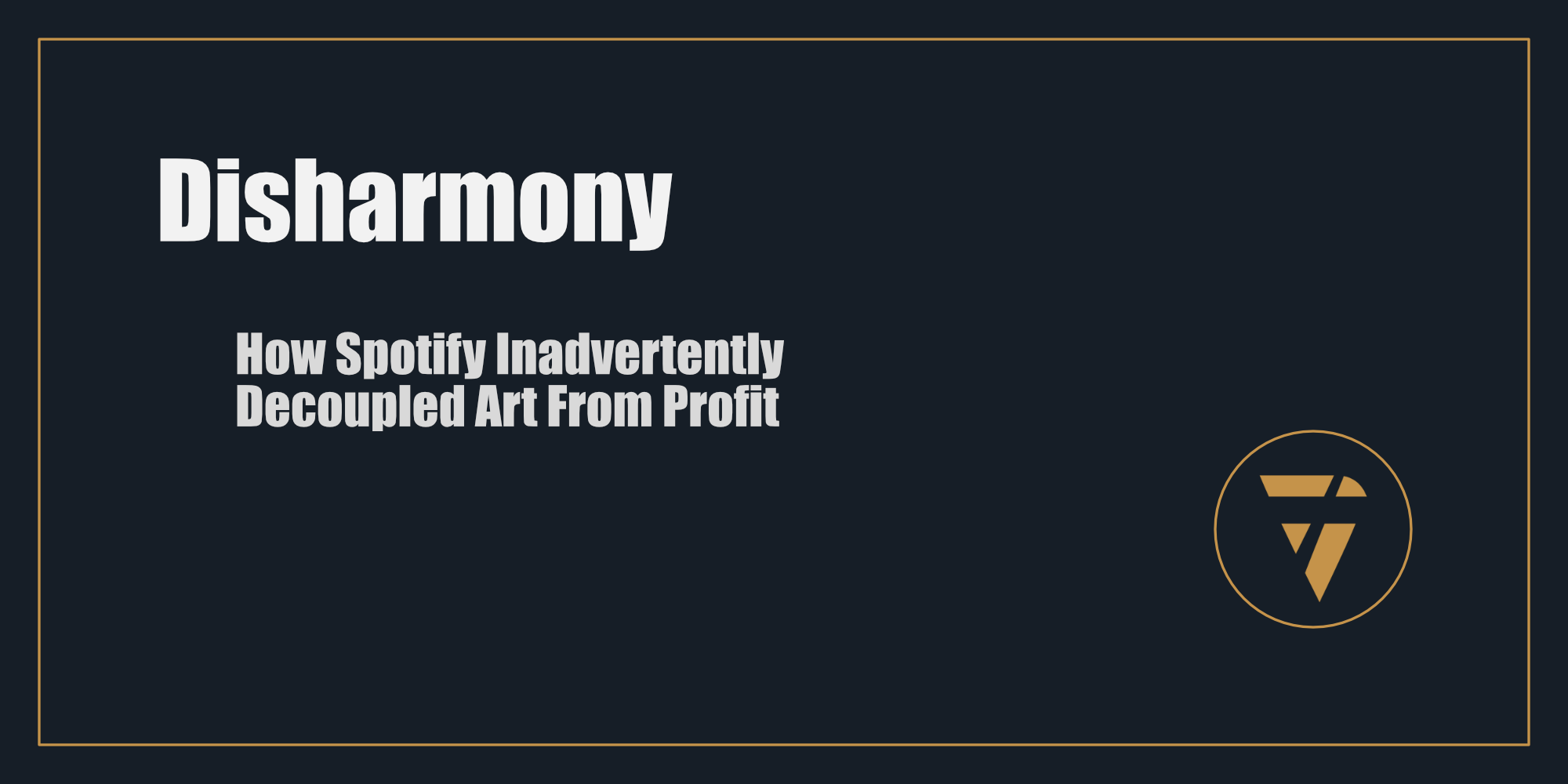Disharmony
How Spotify Inadvertently Decoupled Art From Profit

The Spotify revolution didn’t just disrupt music, it severed the connection between creator and consumer.
When Spotify first emerged, it promised salvation for an industry on the brink. Piracy had gutted revenue streams, physical album sales were collapsing, and artists were struggling to survive. Spotify offered a bold alternative: unlimited music for listeners, coupled with a system to ensure artists got paid. At first glance, it seemed like a win-win, an elegant solution to a messy problem.
But beneath the surface of this streaming utopia, an unintended consequence was brewing. Spotify didn’t just change how music was distributed, it fundamentally altered how it was valued. In prioritizing the needs of its users over the integrity of its creators, Spotify severed a centuries-old bond between artists and their audiences. And with that decoupling came a profound shift in the cultural and economic fabric of music.
The Art of Consumption
Historically, the relationship between artists and their fans was direct and deeply human. Whether through the purchase of a record, the attendance of a concert, or a personal connection to the lyrics of a song, audiences engaged with music as an active choice. They supported artists not just with money, but with loyalty, attention, and advocacy.
Spotify replaced this relationship with something else entirely: a passive, algorithmically driven model. In this system, users no longer actively choose what to listen to, an algorithm does it for them. Playlists curated by data points and engagement metrics have replaced the painstakingly crafted albums that artists once poured their souls into. Music is consumed, but not valued.
This isn’t just a minor inconvenience. It’s a tectonic shift. When artists no longer rely on their audience for financial survival, when their success is determined by streams and playlist placements rather than loyalty and connection, their art becomes untethered from the people it was meant to serve.
The Cost of Convenience
For users, the benefits of Spotify are undeniable. A nearly infinite library of music at your fingertips, accessible anytime and anywhere, is an incredible convenience. But convenience comes with a cost. The listener’s relationship to music becomes transactional, shallow, and passive. Instead of actively seeking out new artists, users rely on algorithms to feed them what’s trending or what suits their mood.
This shift has cultural consequences. Music has become less about discovery, growth, and connection, and more about background noise. Albums, once revered as cohesive artistic statements, have been replaced by singles designed to fit seamlessly into a “chill vibes” playlist. Listeners are exposed to more music than ever, but they engage with it less deeply.
For artists, the cost is even steeper. They no longer create for an audience that buys their work, but for a system that rewards virality and repeatability. The album, with its narrative arcs and intentionality, is often sacrificed in favour of tracks optimized for streams. Artistic risks are discouraged because algorithms favour the familiar.
Spotify didn’t create this problem alone, but its model has amplified it. By turning music into a utility, something consumed without thought or commitment, it has devalued both the art and the artist.
The Search for Meaning
But art, like nature, resists commodification. For every passive listener using Spotify, there is someone else actively seeking deeper connections with creators. And for every artist struggling within Spotify’s ecosystem, there are those forging new paths outside of it.
Independent platforms like Bandcamp, Patreon, and even blockchain-powered technologies like NFTs are enabling artists to reconnect directly with their audiences. Fans who value intentionality are returning to vinyl, attending intimate shows, and supporting creators through crowdfunding. These models aren’t just about income, they’re about restoring the bond between creator and consumer that Spotify inadvertently severed.
This shift is hopeful. It suggests that while Spotify has dominated the music industry, it hasn’t destroyed what makes music valuable. It has simply forced us to reimagine it in new spaces, with new tools.
What Comes Next?
The Spotify revolution may have severed art from profit, but it also exposed the cracks in a broken system. The question now is: how do we rebuild?
For audiences, the answer lies in intention. Choose to support the artists who move you. Seek out platforms and experiences that value creativity over convenience.
For artists, it means embracing new models. Reclaim ownership of your work. Build ecosystems that reward connection and authenticity.
And for platforms, it’s time to step up. Spotify has the potential to be more than a utility. By prioritizing equity, transparency, and meaningful engagement, it can evolve into a space where art and profit coexist harmoniously. Or something better will make it irrelevant.
This is not the end of music, it’s a transformation. By recognizing the challenges Spotify has created, we have the opportunity to create something better. Something that values art not as a commodity, but as the vital, transformative force it has always been.
What role will you play in this transformation? Are you ready to reconnect with the art that shapes our lives?
Share your thoughts, and subscribe for more insights on reshaping the creative economy.
This Substack is reader-supported. To receive new posts and support my work, consider becoming a free or paid subscriber.
This is what I’m working on. Tell me what you think, I enjoy the conversation! Subscribe and follow the work in real time.
Thanks!
B
PS -





